
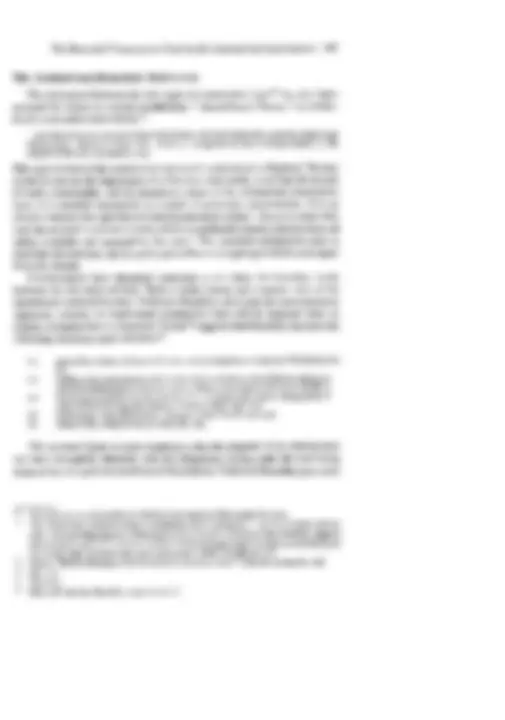
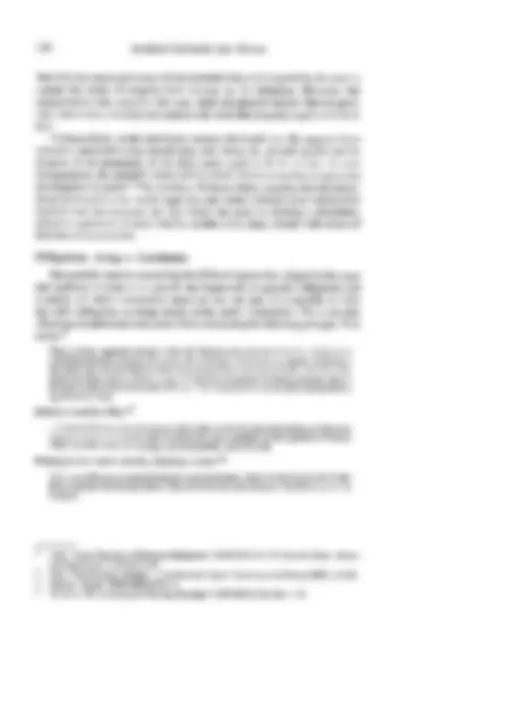
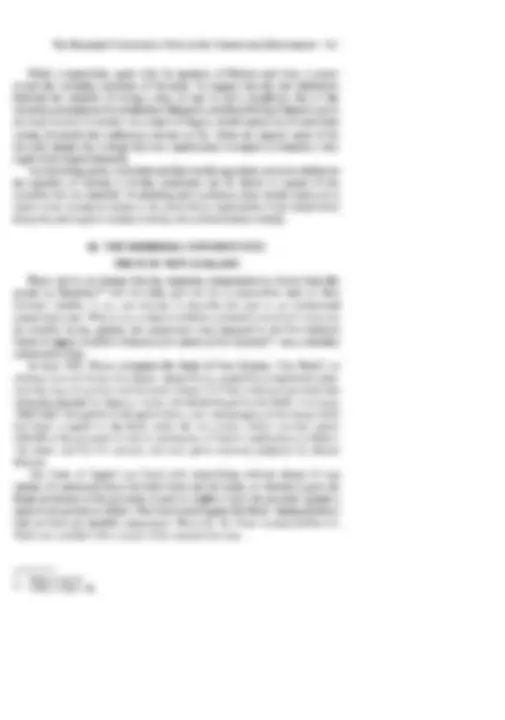


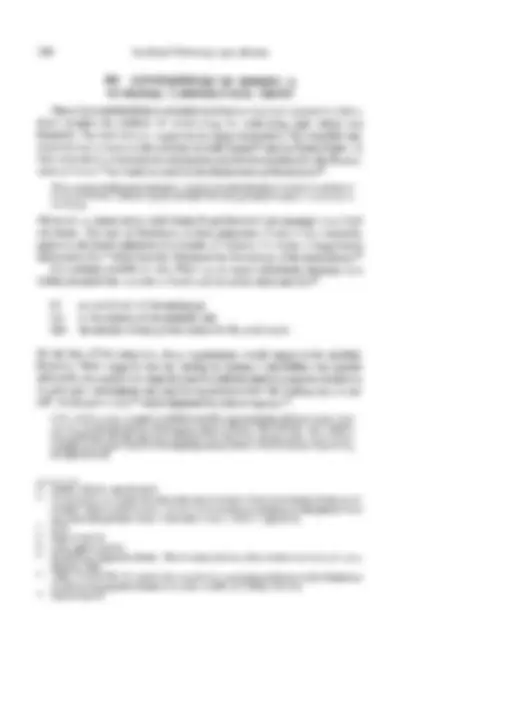
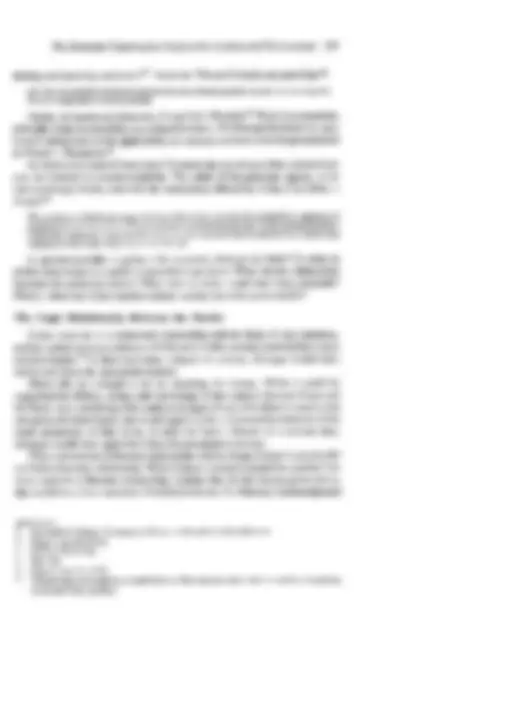
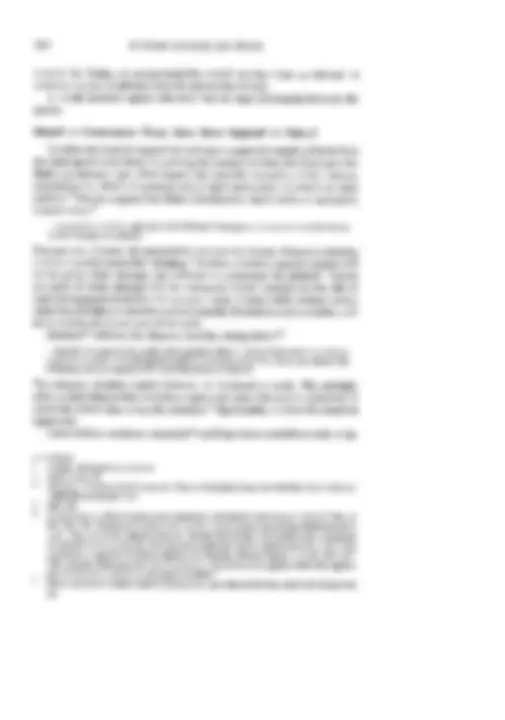
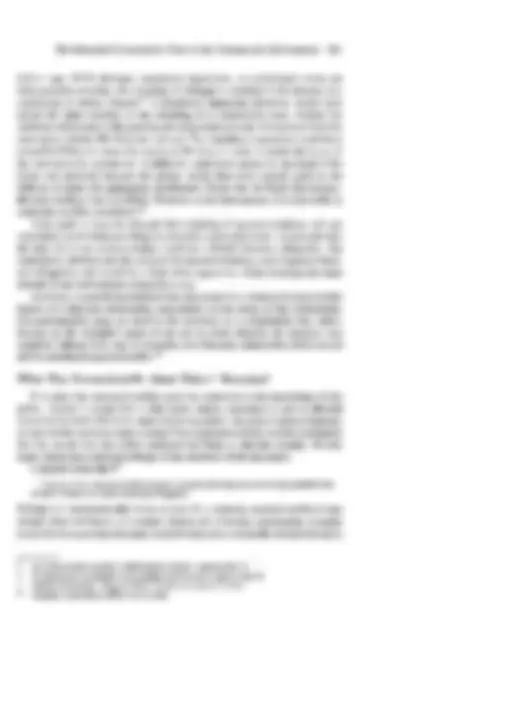
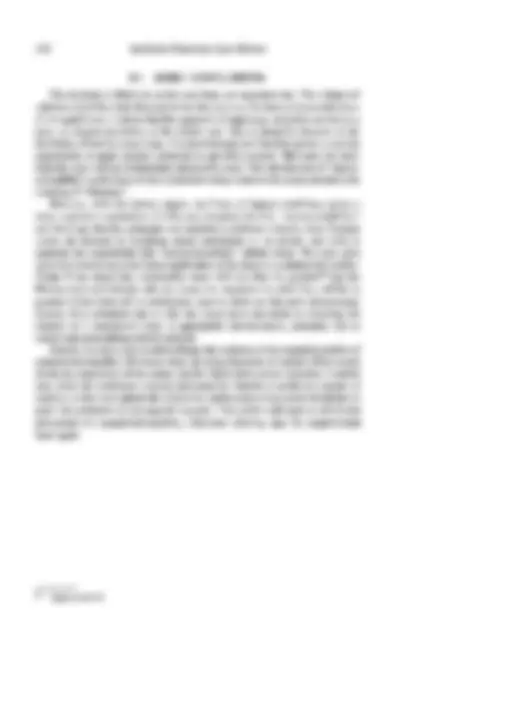


Study with the several resources on Docsity

Earn points by helping other students or get them with a premium plan


Prepare for your exams
Study with the several resources on Docsity

Earn points to download
Earn points by helping other students or get them with a premium plan
Community
Ask the community for help and clear up your study doubts
Discover the best universities in your country according to Docsity users
Free resources
Download our free guides on studying techniques, anxiety management strategies, and thesis advice from Docsity tutors
The development and application of constructive trusts in New Zealand commercial law, focusing on the distinction between institutional and remedial trusts. The article explores various cases and legal frameworks, highlighting the role of unconscionability and commercial morality in the imposition of constructive trusts.
Typology: Lecture notes
1 / 18

This page cannot be seen from the preview
Don't miss anything!











Over the last decade the constuctive trust has sparked^ considerable discussion as it has been applied to an ever-increasing variety^ of^ situations.^ In^ New^ Zealand^ at least, it now appears^ well^ settled^ that^ constructive^ trusts^ are^ a^ viable^ remedy available in de facto cases. In recent years the New Zealand courts have begun to apply constructive trusts more readily in the commercial domain as well. Prior to any sensible discussion of the topic of constructive trusts^ in^ the commercial environment, it is necessary to define what is meant by "constructive trust". It is well settled that an express trust arises by intention of the parties,^ and^ a constructive trust is imposed by the courts. However, there are considerable differences throughout^ the^ common^ law^ world^ regarding^ the^ ambit^ of^ the^ defini- tion and its appropriate application.
***** BCom
Auckland University Law Review
In the United Kingdom the constructive trust is treated as a substantive institu- tion, that is, a type of trust. The express trust and the (^) constructive trust are treated as being closely related, probably because (^) in each case the court is concerned with ensuring that legal title held by (^) one person is retained for the benefit of another. However, the English method has been (^) criticized as being "a cul-de-sac of legal reasoning".' The difficulty (^) with the English position lies in its concentration on the concept of a trust, (^) and its consequent preoccupation with the existence of (^) a fiduciary (^) relationship as a prerequisite to relief. English law has suffered (^) due to the confusion arising from the failure of (^) this approach to explain all the situations where a constructive (^) trust will be awarded. For a time, Lord Denning attempted to expand the scope of equitable remedies, (^2) and some of his reforms have been greeted enthusiastically by commentators. (^3) However, the House of Lords has not extended quite the same welcome to much of Lord Denning's (^) work^4 and the constructive trust in England remains confined to its traditional boundaries. Notwithstanding (^) some comments by Deane J in Hospital Products (^) Ltd v US Surgical Corp,^5 the Australian (^) law of constructive trusts incorporates many of the characteristics embodied in the English law. By contrast, the constructive trust (^) in the United States is treated as being wholly separate from^ the^ express trust:^6 An express trust is a substantive (^) institution. Constructive trust, on the other hand, is purely a remedial institution. For many years now it has been considered that there is only one type of construc- tive trust in^ the^ United^ States, being^ the^ remedial^ constructive^ trust.^ 7 In (^) Canada there may be several constructive trusts. Commenting (^) on the deci- sion (^) in Pettkus v Becker,^8 Professor McClean declared: 9 Even though all constructive trusts may be referable to some general (^) principle of preventing unjust enrichment, some may indeed create a conventional trust; others (^) may result simply in the transfer of title. The exact nature ...will depend upon the type (^) of constructive trust that has arisen. It is a primary submission of this (^) article that the law in New Zealand now recognises two kinds of constructive trust; the institutional constructive trust and the remedial (^) constructive trust.
Waters, The (^) ConstructiveTrust (1964) 3. 2 See for example Lloyds (^) Bank Ltd v Bundy [1975] QB 326. 3 See (^) infra at notes (^) II and (^) 16. 4 See for example the speech (^) of Lord Scarman in National (^) Westminster Bank Plc (^) v Morgan [ 1985] AC 686, 707 (HL). (^5) (1984) 156 CLR (^) 41, 125 (HCA). 6 Pound, "The Progress (^) of the Law, 1918-19 - (^) Equity" (1920) 33 Harv L Rev (^) 420, 420-421. (^7) See Scott, infra (^) at note 43 and accompanying (^) text. (^8) [1980] (^2) SCR 834. 9 McClean, "Comment (^) - Pettkus v Becker" (1982) (^16) UBCLR 155, 168.
Auckland University Law Review
state that the constructive trust will be remedial (^) when it is imposed by the court to compel the return of property held wrongly (^) by the defendant. However, this categorisation only extends to (^) the case where the plaintiff declares that the prop- erty is his or hers, and does not extend to (^) the claim that property ought to be his or hers. Professor Sealy, on the other hand, (^) espouses the broad view. He suggests that a remedial constructive trust should arise only where the plaintiff pleads that the property in the possession of (^) the other party ought to be his or hers. In such circumstances, the plaintiff's claim will be based (^) "not on ownership in equity but on obligation in (^) equity".1^6 By corollary, Professor Sealy considers that the institu- tional constructive trust should apply not only where a breach of an expressed or implied trust has occurred, but (^) also where one party is claiming a proprietary interest in particular property held by (^) another or is suing a holder with notice of that interest in personam.
Obligations Along a Continuum
One possible route to reconciling the different (^) approaches adopted in the cases and academic writings is to consider (^) the framework of equitable obligations and remedies, of which constructive trusts are (^) but one part. It is possible to view equitable obligations as being simply points upon a continuum. This is an idea which has found favour with some writers (^) discussing the fiduciary principle. Finn states:
What is being suggested, though, is that the fiduciary principle should not be considered (^) as something separate, complete and whole; that it belongs, most likely, to a family of doctrines; that these may well be found in time to be informed (^) by a common principle; and that to the extent that these make (^) available a range of behavioural standards of varying intensity, there is the need to identify the factors which determine the appropriateness (^) of one rather than another to a given relationship.
Maxton considers that:^ 18
... it is possible to perceive the factors which make up the fiduciary relationship as at the most rigorous end of (^) a continuum which encompasses other standards for the regulation of human affairs of a like nature, for example, unconscionability and good faith.
Putting it even more broadly,^ Gautreau^ wrote:^19
There is no difference in principle between contractual duties, duties of care based on the (^) Hedley Byrne principle and (^) fiduciary duties. They all involve the same elements. The difference is only in degree.
6 Sealy, "Some Principles (^) of Fiduciary Obligations" [1963] CLJ 119, 123. See also Sealy, "Fiduci- ary Relationships" (^) [1962] CU 69. 17 Finn, "The Fiduciary Principle", in Youdan (ed), Equity, (^) Fiduciariesand Trusts (^) (1989) 1, 55-56. (^18) Maxton, "Equity" (^) [1990] NZRLR (^) 89, 91. '9 Gautreau, "Demystifying (^) the Fiduciary Mystique" (1989) 68 Can Bar Rev 1, 29.
The Remedial Constructive Trust in the CommercialEnvironment 151
While I respectfully agree with the opinions of Maxton and Finn, I cannot accept the sweeping statement of Gautreau. To suggest that the only difference between the situation of owing a duty of care to one's neighbour, that of the voluntary assumption of a contractual obligation, and that of being obliged to act in the best interests of another, is a matter of degree, would appear to be manifestly wrong. It extends the continuum concept too far. These are separate areas of the law and, despite the overlaps that exist (particularly in respect of remedies), they ought to be treated distinctly. An interesting point, somewhat ancillary to this argument, arises in relation to the question of whether a similar continuum can be drawn in respect of the remedies that are available. In adopting such a concept, there would need to be a break in the continuum drawn at the point where constructive trusts switch from being the presumptive remedy to being only a discretionary remedy.
There can be no dispute that the situations (^) extrapolated by Dewar from the article by Maudsley 20 will normally give rise to a constructive trust in New Zealand, whether or not one chooses to describe the trust as an institutional constructive trust. What is not so clear is whether a remedial constructive trust can be awarded. In my opinion, the constructive trust imposed by the New Zealand Court of Appeal in Elders PastoralLtd v Bank of New Zealand 21 was a remedial constructive trust. In June 1987, Elders persuaded the Bank of New Zealand ("the Bank") to advance sums of money to a farmer named Gunn, secured by a registered instru- ment by way of security over his stock. Clause 15 of the instrument provided that all money payable in respect of stock sold should be paid to the Bank. In January 1988 Gunn, through his stock agent Elders, sold some progeny of the sheep which had been assigned to the Bank under the instrument. Elders retained nearly $58,000 of the proceeds of sale in satisfaction of Gunn's indebtedness to Elders. The Bank sued for this amount, and were given summary judgment by Master Hansen. The Court of Appeal was faced with determining whether clause 15 was merely of contractual force between Gunn and the Bank, or whether it gave the Bank an interest in the proceeds of sale or a right to trace the proceeds against a party in the position of Elders. The Court found against the Bank, stating that there had not been an equitable assignment. However, the Court recognised that the Bank was entitled to the remedy of the constructive trust.
20 Supra at note 15. 21 [198912 NZLR 180.
The Remedial Constructive Trust in the Commercial Environment 153
In effect, the last sentence of the extract from the judgment of Bingham J provides the basis for the decision of Cooke P. His Honour assessed the close relationship of proximity and knowledge^ between^ the^ three parties^ and^ concluded^ quite simply:^ 26
I do not think that (^) in conscience the stock agents can retain this money. Significantly, at no point in his judgment did Cooke P use the word "fiduciary". His Honour imposed^ a^ constructive trust because^ it was "less^ than^ conscionable"^
27
for Elders to retain the money. In his judgment, Somers J dealt first with the failure of clause 15 to protect the Bank adequately, and then discussed whether there was another basis on which to found an^ equitable^ right.^ He^ declared^ that:
28
[The Bank] would have such (^) an interest if Mr Gunn or Elders stood in a fiduciary relationship to the Bank or, if, which in the present context comes to much the same thing, the moneys received by Elders could not conscientiously be appropriated by it against the Bank. His Honour appears to be suggesting that actions against conscience give rise to the same consequences as a breach of a fiduciary relationship. Somers J goes on to conclude that there was an implied obligation upon Mr Gunn which was "fiduciary in character". 29 This is because the sum in dispute was the proceeds of the sale of stock which, by virtue of the security, were the property of the Bank pending sale. Since Elders were the agent of Mr Gunn, and could not stand (^) in a better position than their principal, Somers J determined that the proceeds of the sale must be held by Elders for the Bank. This reasoning goes further than that of Cooke P in alleging a fiduciary relationship. However, one must question whether Somers J is committed to the existence of a such a relationship. First, his Honour uses the expression "fiduciary in character" rather than simply "fiduciary". Second, in granting the remedy of a constructive trust his Honour quotes and refers to the very same passages from Goff and Jones and Neste Oy as those reproduced from the judgment of Cooke P above. Those extracts categorically declare that a fiduciary relationship is not a necessary prerequisite to the imposition of a constructive trust. Furthermore, as Somers J himself^ concludes:^ 30
[A constructive trust] has (^) come to be used as a device for imposing a liability to account on persons who cannot in good conscience retain a benefit in breach of their legal or equitable obligations. It is therefore unclear exactly what is ratio and what is obiter in this judgment. Admittedly, it might be possible to class the relationship as fiduciary, although
26 Supra at note 21, at (^) 186. 27 Ibid. 2S Ibid, 191-192. 9 Ibid, 192. What does "fiduciary in character" mean? Is it something less than a fiduciary relationship? 30 Ibid, 193.
Auckland University Law Review
that would put a great deal of strain on the word. 3 ' It appears that relevant, but not conclusive, factors going to the establishment of a fiduciary relationship include; dominance, vulnerability, dependence, honesty, loyalty, reliance, and acceptance by one party of an obligation to act (^) in the best interests of the other. 32 At least the first (^) three, and the last, of these criteria would appear to be absent in this case, given that the Bank had the opportunity to protect its own interests in the contract with Gunn. As Mason J pointed out^ in^ the^ Hospital^ Products^ decision:^ 33
... the existence of a basic contractual relationship has in many situations provided a foundation for the erection of a fiduciary relationship. In these situations it is the contractual foundation which is all important because it is the contract that regulates the basic rights and liabilities of the parties. The fiduciary relationship, if it is to exist at all, must accommodate itself to the terms of the contract so that it is consistent (^) with, and conforms to, them.
Furthermore, as stressed by both Gibbs CJ and Dawson J in that case, fiduciary obligations will not be imposed to remedy the inadequacy of the parties' contrac- tual arrangement.^
34 The essence of the judgment of Somers J appears to be that the relationship which existed was very close to a fiduciary (^) one. On this basis, and owing to the unconscionable (^) behaviour of Elders, the money must be held on constructive trust. Richardson J authorised Cooke P to say that "broadly for the same reasons given in [the judgment of Cooke P] and the judgment of Somers J he also would dismiss the^ appeal".^ 35 On the basis of the above analysis, (^) I conclude that a remedial constructive trust was imposed in Elders. In order to constitute an institutional constructive trust, a breach of a fiduciary relationship would be required. As Waters wrote in reference to the^ English institutional^ constructive^ trust:^
36
[T]he fiduciary relationship is clearly wed to the constructive trust over the (^) whole, or little short of the whole, of the trust's operation.
31 A not uncommon occurrence; see for example Chase Manhattan Bank NA v Israel-British Bank (London) Ltd [1981] Ch 105, and Goodbody v Bank of Montreal; Goodbody v Lester (1974) 47 DLR (3d) 335, (^339) (Ont HC), where the Court permitted the plaintiffs to trace in equity and recover the sale proceeds of certain share warrants belonging to them that had been wrongfully acquired and sold by the defendant, Lester. In answer to the defendant's submission that the equitable remedy was not available in the absence of a fiduciary relationship, it was held that, in view (^) of the defendant's guilty involvement in the acquisition and sale of the warrants, "the Court will establish a fiduciary relationship to enable the plaintiffs to follow their property (^) in equity into Lester's bank account", per Lacourciere J. 32 accept, (^) of course, that this is by no means a (^) definitive list. The authorities contain much (^) guidance as to the duties of one who is in a fiduciary relationship with another, but provide no comprehen- sive statement of the criteria by reference to which the existence of a fiduciary relationship may be established. 33 Supra (^) at note (^) 5, at 97. (^34) Ibid, 143. (^35) Supra at (^) note 21, at 186. 36 Supra at note 1, at 33.
Auckland University Law Review
Once it is established that a remedial constructive (^) trust was imposed in Elders, there remains the problem of (^) ascertaining the underlying right which was breached. The most obvious suggestion is unjust enrichment. The remedial con- structive trust is based on this doctrine in both Canada^42 and (^) the United States. In fact, in the latter jurisdiction the constructive trust is not considered (^) in the Restate- ment of Trusts,4 3^ but^ rather^ is^ stated^ in^ the^ Restatement^ of^ Restitution: 44
Where a person holding title to property is subject to an equitable duty to convey (^) it to another on the ground that he would be unjustly enriched if he were permitted to retain (^) it, a constructive trust (^) arises. Moreover, (^) as stated above, both Cooke P and Somers J cite passages from (^) Goff and Jones' The Law of Restitution in their judgments. Cooke (^) P also impliedly approves the broad statement of principle of Cardozo J in Beatty v (^) Guggenheim Exploration Co, 45 which^ heavily influenced^ the^ formulators^ of^ the^ Restatement.^46 It is perhaps possible to view Elders as an unjust enrichment situation. It is widely accepted that, in^ order^ to^ found^ such^ an^ action,^ there^ must^ be:^47
(i) an enrichment (^) of the defendant; (ii) at the expense of the plaintiff; and (iii) the (^) absence of any juristic reason for the enrichment.
On the face of the judgments, these requirements (^) would appear to be satisfied. However, Watts suggests that the finding by Somers (^) J that Elders was equally affected by the constructive trust because it (^) could not stand in a superior position to its principal. Furthermore, this (^) may be inconsistent with "the leading case on set- off', Roxburghe v Cox, 48 which happened to^ concern agency:^49
In the ordinary course, (^) an agent is entitled to set off, in any accounting with its principal, sums owed to it by the principal (see (^) Bowstead on Agency (15th ed, 1985) 246-247), and it appears from (^) Roxburghe that that right is no different from that of an ordinary debtor. Such (^) persons generally need to have (^) notice of the competing security interest of the third party before losing the right of set (^) off.
42 Pettkus v Becker, supra at note 8. 43 Except insofar as a constructive (^) trust arises out of a breach of (^) duty by an express trustee; (^) as, for example, where an express trustee in breach of trust transfers trust property to a third person who is not a bona fide purchaser: Scott, "Constructive Trusts" (1955) 71 LQR (^) 39, 41. (^44) §160. 45 Supra (^) at note 24. 46 Scott, supra at note 43. (^47) Kos & Watts, Unjust Enrichment - The New Cause ofAction (New Zealand Law (^) Society Seminar, February (^) 1990). 48 (1881) 17 Ch D 520. (^) For a recent and comprehensive (^) examination of the law in New Zealand (^) on set-off see the judgment of Somers J in Grant v NZMC Ltd [1989] (^1) NZLR 8. (^49) Supra (^) at note 37.
The Remedial Constructive Trust in the Commercial Environment 157
This would appear to provide a juristic reason for the enrichment, with the crucial factor being^ the^ knowledge^ of^ Elders.^
50
In any event, it is unlikely that the Court of Appeal based its decision on unjust enrichment. The status of this doctrine in New Zealand law is uncertain. In 1983 Cooke J^ was^ of^ the^ opinion that:
5 1
The scope of [unjust enrichment] in New Zealand is unsettled. Safely if tritely one can say that it may be evolving.
The law does not appear to have changed substantially since then, although in Gillies v Keogh 52 his Honour appeared to take unjust enrichment more seriously, equating it to^ other^ more^ established^ principles:^
53
Normally it makes no practical difference in the result whether one talks of constructive trust, unjust enrichment, imputed common intention or estoppel. In deciding whether any of these are established it is necessary to take into account the same factors. However, it cannot yet be said that unjust enrichment has become accepted^ in New Zealand as a cause of action. Perhaps it should be, and perhaps it soon will be. However, if and when it is, the Court of Appeal will need to state the position clearly. To assert that unjust enrichment formed the basis for the decision here would be to allow the doctrine in through a side door, and it is unlikely that the Court would have taken such^ an^ important^ step^ in^ that^ manner.^
54
In any respect, I do not believe that unjust enrichment encompasses the real tenor of this decision. It is submitted that a constructive trust was^ awarded^ in Elders to remedy an action which was unconscionable.
The Meaning of Unconscionability There is^ a^ vocabulary^ trap^ which^ many^ judges^ and^ commentators^ fall^ into when using the word "unconscionable". In strict terms, unconscionability is a narrow and specific form of equitable relief stemming from two distinct areas. The first is the general equity in favour of heirs and expectants to prevent "catching bar- gains". 55 The^ second^ is^ that^ outlined^ by^ Kay^ J^ in^ Fry^ v^ Lane:
5 6
The result of the decisions is that where a purchase is made from a poor and ignorant man at a considerable undervalue, the vendor having no independent advice, a Court of Equity will set aside the transaction. Recent examples of the application of this principle include Blomley v^ Ryan^57 and
o For further discussion, see text, infra at p161. 5' Hayward v Giordani [1983] NZLR 140, 148. 52 [1989] 2 NZLR 327. Decided after Elders. 5 Ibid, 330. 5 Witness the clear and explicit manner in which the House of Lords redefined the law of torts in Donoghue v Stevenson [1932] AC 562. 55 See the judgment (^) of Lord Hardwicke in Earl of Chesterfield (^) v Janssen (1750) 2 Ves Sen 125; 28 ER 82. 56 (1888) (^40) Ch D 312, (^) 322. 57 (1956) (^99) CLR 362.
The Remedial Constructive Trust in the Commercial Environment 159
dealing and^ knowing^ assistance.^ (^65) However, Thomas J clearly accepted that: 66
[I]n New Zealand the constructive trust has become a broad equitable remedy^ for^ reversing^ that which is inequitable or unconscionable. Finally, in^ EquiticorpIndustries^ Group^ Ltd^ v Hawkins^67 Wylie^ J^ accepted^ the principle of unconscionability as^ outlined^ in^ Elders. His^ Honour^ did,^ however,^ take a more limited view^ of^ the^ applicability^ of^ constructive^ trusts^ than^ that^ propounded in Powell v^ Thompson.^
68
So what is the result^ of^ these^ cases? It^ seems^ that^ an^ action^ in^ New^ Zealand^ can now be founded^ on^ unconscionability.^ The^ ambit^ of^ this^ principle appears^ to^ be disconcertingly broad, even with the reassurance offered by Cooke P in^ Gillies^ v Keogh: The experience of the Courts suggests that [de facto cases] are very often marked by a vagueness of intention not expected and less commonly found in commercial dealings. In the commercial sphere I think that constructive trusts should clearly be much more difficult to establish. It is a truism that certainty is^ particularly valued^ in^ commercial^ law. If unconscionability is going to be accepted, what are its limits? In order to define these limits it is useful to pose three questions: What was the relationship between the parties in Elders? What other^ remedies^ might^ have^ been^ available? Finally, what was it that rendered Elders' actions less than conscionable?
The Legal Relationship Between the Parties Elders were not in a contractual relationship with the Bank. If they had been, actions carried out in accordance with the terms of the contract could not have been unconscionable. 70 If there had been a breach of contract, damages would have surely have been the appropriate remedy. Elders did not^ commit^ a^ tort^ by^ retaining^ the^ money.^ While^ it^ could^ be suggested that Elders, acting with knowledge^ of^ the^ contract^ between^ Gunn^ and the Bank, were interfering^ with^ contractual^ rights (those^ of^ the^ Bank^ to^ receive^ the sale proceeds from^ Gunn), that would appear^ to^ be^ a^ considerable extension^ of^ the usual parameters of that action. If there had been a breach of a tortious duty, damages would^ once^ again^ have been^ the^ presumptive^ remedy. Elders were not in a fiduciary relationship with the Bank. Cooke P certainly did not find a fiduciary relationship. While^ Somers^ J^ seemed^ tempted^ to^ consider^ that there might be^ a^ fiduciary^ relationship,^ I^ submit that,^ for^ the^ reasons given^ above, this would have been incorrect. Certainly however, if a fiduciary relationship had
65 See Fardell & Fulton, "Constructive Trusts - A New Era" [1991] NZLJ 90. 6 Supra at note 64, at 615. 67 [1991]3 NZLR 700. 6' Ibid, 728. 9 Supra at note 52, at 333. 71 With perhaps the (^) exception, as stated above, of the situation where there is (^) manifest wrongdoing on the part of the promisee.
Auckland University Law Review
existed, the finding of unconscionability (^) would not have been as relevant. A constructive (^) trust would have been the appropriate remedy. It would therefore (^) appear that there was no legal relationship (^) between the parties.
Should (^) a Constructive Trust Have Been (^) Imposed in Elders? In Elders the (^) Court of Appeal was seeking to compel the transfer (^) of funds from the stock (^) agents to the Bank. In granting the constructive trust, the Court gave the Bank (^) a proprietary right. With respect, this could (^) be viewed as a little extreme, considering the effects of granting (^) such a right (particularly in relation (^) to third parties). 71 Maxton suggests that those consequences might not be of such (^) grave concern since:^ 72
a proprietary remedy ought only (^) to be effected if damages or an account of profits do (^) not provide adequate recompense. Damages are, of course, the (^) presumptive common law remedy. Maxton is (^) referring to what is usually termed (^) the "adequacy" doctrine, whereby a specific (^) remedy will not be given where damages (^) are sufficient to compensate the plaintiff. (^) Typical examples (^) of where damages will be inadequate include contracts for the sale of land and (^) negligent destruction of a unique chattel. A (^) more subtle instance occurs where the defendant (^) is insolvent and the plaintiff, if treated (^) as only a creditor, will fail to recover all (^) or even part of the claim. Paciocco 73 criticises the^ adequacy^ doctrine, stating^ that^ it:^74 ... begs the very question that (^) needs to be answered: when is it just and appropriate (^) to confer on a plaintiff (^) the priority over the general creditors of the defendant? The answer according to the inadequacy doctrine appears to be 'when that priority is required'. The adequacy doctrine cannot, however, be displaced so easily. The principle refers to more than just (^) the proprietary rights with which Paciocco (^) is concerned. It covers the whole range of specific (^) remedies. 75 Significantly, it covers the award (^) of injunctions. I submit that a mandatory injunction (^76) could have been a suitable remedy in the
71 Usually, and especially, creditors. (^72) Supra at note 18. 73 Paciocco, "The Remedial (^) Constructive Trust: A Principled' (^) Basis For Priorities Over Creditors"
74 (1989)Ibid, 68 Can^ Bar^ Rev^ 315. 339. 75 In any respect, (^) as Horack points out in "Insolvency (^) and Specific Performance" (^) (1918) 31 Harv L Rev 702, 720: "Jurisdiction to grant (^) relief and the exercise thereof are entirely different proposi- tions". Thus even if the (^) adequacy doctrine indicates that damages will insufficiently compensate the plaintiff for his or her loss, that does not (^) compel the court to award proprietary relief. This conclusion is supported by Martin, Hanbury & (^) Maudsley, Modem Equity (1 th ed, 1981) 675: "The remedies, being equitable, are discretionary, (^) and should not be applied where their applica- tion would not be conducive (^) to the pursuit of justice." 7 That is, one which compels (^) a party to do some act, rather than prohibiting a (^) party from doing some act.
Auckland (^) University Law Review
relationship. Although Elders may not have initially retained (^) the money with actual knowledge of the terms of (^) the contract between Mr Gunn and the Bank, particularly the stipulations contained (^) in clause 15, they continued to hold the money after the Bank had made demand for it. Cooke P is careful to note that:8 1 Elders are taking a stand on what (^) they believe to be their legal rights. Their good faith is not in question. Nevertheless, it was held that it was unconscionable for (^) Elders to retain the money. It would have been (^) "sharp practice" for them to do so. This is extremely significant. Without too much ado, the Court of Appeal appears to have introduced a new emphasis on commercial morality.
Commercial Morality The concept of commercial morality has been regaining ground (^) over recent years, especially (^) in Canada and the United States. 82 The similarity between (^) con- structive trust remedies in New Zealand and Canada heightens (^) the potential influence which Canadian decisions could exert (^) on our courts. 83 A prominent example of the resurgence of remedies for (^) breach of commercial morals in Canada is the decision of the Supreme Court in InternationalCorona Resources Ltd v LAC Minerals (^) Ltd.^84 In New Zealand a recent example (^) is the decision of Thomas J in Pacific Industrial CorporationSA v Bank (^) of New Zealand.^85 The Bank loaned a consider- able sum of money to N Ltd, whose financial position subsequently deteriorated to the point where (^) it was forced to approach C Ltd for assistance. C Ltd agreed (^) to help if loan finance from the Bank would continue and, (^) to that end, C Ltd approached the Bank. In its written (^) response, the Bank indicated to C Ltd its acceptance of a pricing structure (^) and repayment schedule previously discussed by the parties. The Bank later wrote to N Ltd setting out its terms and some (^) deadlines for this extension. However the Bank did not (^) inform C Ltd of these details. The deadlines were not met and the Bank served a notice of default on (^) N Ltd. Once apprised of the situation, C Ltd met the conditions (^) in default and brought an action to restrain the Bank from exercising (^) its powers of possession and sale under its mortgage. While several issues were disputed before (^) Thomas J, the issue of relevance here is the suggestion that the Bank owed a duty to (^) C Ltd. This was accepted by his Honour: 86
I consider that the (^) bank would be under an implied obligation to notify [C Ltd] of its intention (^) to demand repayment (^) of the facility. On both the law and the facts this is clearly arguable and, (^) indeed, it is an argument which may eventually (^) prevail.
SI (^) Supra at note 21, at 186. 82 One example is the United States concept (^) of "good faith bargaining" in respect of the formation of contracts. In Australia, Paul Finn also appears to support (^) this concept: supra at note 17. 83 Notwithstanding the debate over unjust enrichment. [1989] 2 SCR 574. (^85) [1991] (^1) NZLR (^) 368. (^16) Ibid, (^) 375.
The Remedial Constructive Trust^ in^ the^ CommercialEnvironment^^163
Thomas J did not cite any authority to support this conclusion. There^ was^ no contract between^ the^ parties,^ and the^ question^ arises^ as^ to^ whether^ this^ implied obligation is tortious or fiduciary. It^ is^ probably^ the^ latter.^ His^ Honour^ appeared^ to consider it was arguable that^ there^ was^ a^ fiduciary^ relationship,^ due^ to^ the^ reliance of C Ltd on the Bank. However,^ with^ respect,^ it^ is^ submitted that^ this^ reasoning^ is incorrect. Surely this is not a situation where the^ Bank^ can be seen^ to^ have^ accepted the obligation to^ act in the^ best interests^ of^ C^ Ltd,^ rather^ than^ itself:^
87
It is the undertaking to act for and on behalf of another which imports^ the^ fiduciary^ responsibility. I would suggest that here, as in Elders and InternationalCorona^ Resources,^ there was no legal relationship between the parties. In^ my^ view,^ it^ is^ entirely^ possible^ to conclude that Thomas J was^ declaring^ the^ actions^ of^ the^ Bank^ to be^ unconscion- able. It would appear that in situations where there is no legal relationship to provide guidance as to the true intentions of the parties involved, and^ to^ provide^ a^ peg^ on which to hang liability, the courts are imposing a commercial morality^ on^ the parties. At^ the^ centre^ of^ this^ is^ the^ term^ "unconscionability".
Source of the Liability One explanation alluded to^ earlier^ is^ that^ the^ courts^ are^ now^ considering^ the obligations of parties as points on a continuum.^ While^ I^ do^ not^ consider^ it^ possible to go so far as to include upon this line all duties^ that may arise,^ I^ submit that^ the continuum concept goes at least some way^ towards^ providing^ an^ understanding^ of the reasoning of the judges. One obvious goal of fiduciary obligations is to provide for commercial^ stand- ards. If^ one^ accepts^ the^ suggestion^ of^ Maxton^ that^ unconscionability^ falls^ near^ to fiduciary relations at the^ rigorous^ end^ of^ this^ continuum,^ then^ the^ courts^ are^ simply extending the morality aspect^ of^ the^ fiduciary^ relationship^ (and, indeed,^ some remedies of the fiduciary relationship)^ along this^ continuum.^ This conclusion draws considerable strength from an extrajudicial^ speech^ of^ Sir^ Robin Cooke, addressing the^ Australasian^ Universities^ Law Schools^ Association^ in^ July^ 1989. In his consideration of^ "fairness",^ his^ Honour^ stated^ in^ respect^ of^ the^ Elders decision:
89
As a matter of fair commercial dealing it was difficult to see that there could^ be^ any^ reasonable doubt [that the agents must hold the proceeds for^ the bank]^ ...I^ venture^ to submit^ this^ case^ as quite strong evidence that we are^ ready^ to^ do^ what^ we^ reasonably^ can to allow fairness to^ have decisive weight in^ ...New^ Zealand^ jurisprudence.
87 StandardInvestments Ltd v CanadianImperial Bank of Commerce (1983) 5 DLR (4th) (^) 452, 483 (Ont HC). 88 Published in (1989) 19 VUWLR 421. 89 Ibid, 432-433.